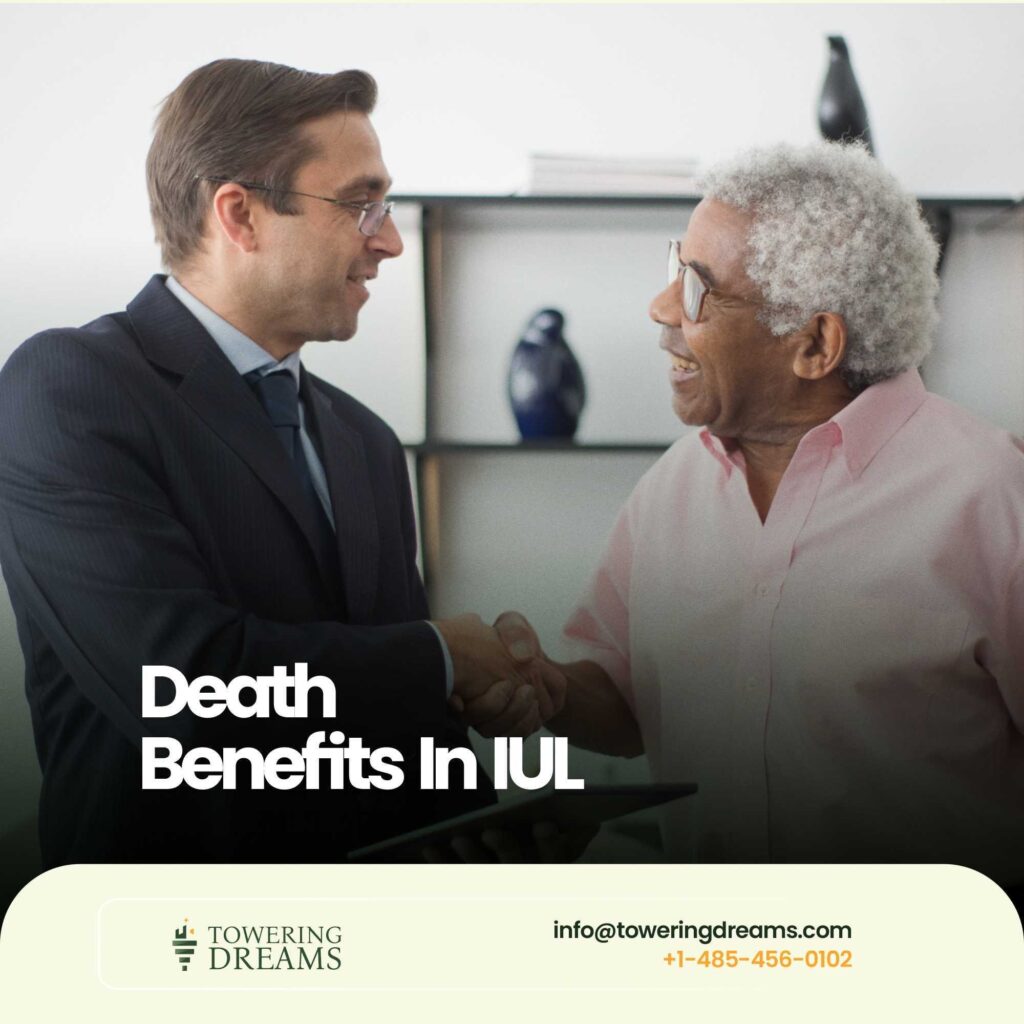
When you buy an Indexed Universal Life (IUL) insurance policy, you’re often drawn to the cash value growth potential, tax advantages, and flexibility. But let’s not forget the fundamental purpose of any life insurance: the death benefit that protects your loved ones when you’re gone.
The death benefit is the amount your beneficiaries receive when you pass away. While IUL policies offer compelling living benefits through cash value accumulation, the death benefit remains the cornerstone feature that makes IUL insurance rather than just an investment vehicle.
Understanding how death benefits work in IUL policies is crucial because they operate differently than term life insurance or even traditional whole life policies. IUL offers options—different death benefit structures, flexibility to adjust coverage, and features that affect how much your beneficiaries ultimately receive.
Whether you’re considering purchasing an IUL or already own one, understanding these death benefit options helps you structure your policy to match your goals. Are you primarily focused on leaving a legacy? Building cash value with some death benefit protection? Planning for estate taxes? Your answers determine which death benefit option makes sense for your situation.
Summary
Death benefits in Indexed Universal Life insurance provide guaranteed, income-tax-free payments to beneficiaries upon the insured’s death. IUL policies offer two primary death benefit options: Option A (level death benefit) maintains a fixed amount with cash value growing inside that amount, ideal for maximizing cash value accumulation, while Option B (increasing death benefit) provides the face amount plus accumulated cash value, prioritizing legacy and estate planning. Death benefits remain in force as long as sufficient cash value covers policy charges, can be adjusted throughout the policy life, and pass to beneficiaries without income taxation. Factors affecting death benefits include premium payments, policy loans, cash value performance, fees and charges, and chosen riders. Understanding these elements helps policyholders structure coverage appropriately, balance death benefit protection with cash value goals, and ensure beneficiaries receive intended protection when it matters most.
The Two Death Benefit Options

IUL policies offer two fundamental death benefit structures, each serving different purposes and creating different outcomes for cash value growth and legacy planning.
Option A: Level Death Benefit provides a fixed death benefit amount. When you purchase the policy, you choose a specific coverage amount—say $500,000—and that remains your death benefit regardless of how much cash value accumulates. As cash value grows, it becomes part of that $500,000, not in addition to it.
Here’s how it works: If you have a $500,000 death benefit and $100,000 in cash value, your beneficiaries receive $500,000 when you die. The $100,000 cash value is included within that amount. As your cash value grows to $200,000, beneficiaries still receive $500,000 total.
Option A is ideal when your primary goal is cash value accumulation. Since the death benefit stays level, more of your premium goes toward building cash value rather than increasing death benefit costs. The insurance company’s “at risk” amount decreases as cash value grows—they only have to pay the difference between cash value and the total death benefit.
Option B: Increasing Death Benefit provides the face amount plus the cash value. With this option, your beneficiaries receive both the base coverage amount and whatever cash value has accumulated—effectively an increasing total death benefit as cash value grows.
Using the same example: With a $500,000 face amount and $100,000 in cash value, beneficiaries receive $600,000. When cash value grows to $200,000, they receive $700,000.
Option B prioritizes legacy maximization and estate planning. It ensures your beneficiaries receive the full cash value you’ve built plus the base death benefit. However, the increasing death benefit means higher insurance costs over time, which can limit cash value accumulation compared to Option A.
Some policies allow you to switch between options under certain conditions, though this may require underwriting or evidence of insurability. Understanding these options at purchase helps you choose appropriately for your goals.
How Death Benefits Work in IUL

Understanding the mechanics of IUL death benefits helps clarify how your policy actually functions over its lifetime.
When you die, your beneficiaries file a claim with the insurance company, providing a death certificate and necessary documentation. Once processed, the insurance company pays the death benefit—typically within 30-60 days of receiving complete claim documentation.
The death benefit is income-tax-free to beneficiaries. This is one of life insurance’s most powerful features. Whether the benefit is $100,000 or $10 million, beneficiaries receive the full amount without federal income tax. This differs dramatically from inherited retirement accounts or other assets that may carry tax obligations.
The death benefit includes any accumulated cash value (in Option A, it’s part of the benefit; in Option B, it’s in addition to the base amount). This means you can’t “double dip”—beneficiaries receive the death benefit, and any cash value becomes part of that benefit rather than an additional inheritance.
Policy loans reduce the death benefit dollar-for-dollar plus any accrued interest. If you have a $500,000 death benefit and take a $50,000 loan with $5,000 in accrued interest, your beneficiaries receive $445,000 upon your death. Unpaid loans and interest are deducted from the benefit.
The death benefit pays only if the policy remains in force when you die. If your policy lapses due to insufficient cash value to cover charges, there’s no death benefit. Maintaining adequate cash value or making premium payments ensures the policy stays active.
Riders and additional coverage increase the base death benefit. Accidental death riders, child riders, or other coverage additions affect the total amount beneficiaries receive depending on circumstances of death and which riders are active.
Suicide clauses typically apply for the first two years. If death occurs by suicide within this period, the insurance company may only return premiums paid rather than paying the full death benefit. After two years, death by suicide is covered like any other cause of death.
Understanding these mechanics prevents surprises and helps you manage your policy for optimal benefit protection.
Factors That Affect Death Benefits

Several factors influence your death benefit amount over time, and understanding them helps you maintain the protection you intend.
Premium payments directly impact policy performance. Paying only the minimum keeps the policy in force but provides minimal cash value growth, which can eventually threaten the death benefit if charges exceed cash value. Robust premium payments build cash value that sustains the policy and potentially increases death benefits.
Index performance affects cash value accumulation, which in turn affects the policy’s ability to sustain itself. Strong index performance builds cash value that covers ongoing charges and potentially increases death benefit under Option B. Poor performance means charges eat into cash value, potentially threatening the policy’s sustainability.
Policy charges and fees constantly deduct from cash value. Cost of insurance charges increase with age, administrative fees reduce cash value, and other charges chip away at accumulation. Over decades, these charges significantly impact total cash value and the policy’s ability to maintain death benefits.
Policy loans reduce death benefits directly and also reduce the cash value earning index returns. This double impact means loans should be considered carefully. Large outstanding loans can threaten policy performance and reduce the legacy you intended to leave.
Withdrawals permanently reduce cash value and potentially trigger reductions in death benefit depending on policy rules. Unlike loans which can theoretically be repaid, withdrawals permanently deplete the policy.
Age and health changes don’t directly reduce existing death benefits, but they affect your ability to increase coverage. If you want to add more death benefit later in life, you may face higher costs or be uninsurable due to health changes.
Lapse and reinstatement can affect death benefits. If your policy lapses and you reinstate it, terms may change, and you may face new underwriting or contestability periods.
Chosen riders like chronic illness or long-term care riders that provide accelerated death benefits while living reduce the amount available to beneficiaries if you use these benefits.
Managing these factors through appropriate premium payments, careful loan management, and regular policy reviews helps maintain the death benefit protection you’ve established.
Level vs. Increasing: Choosing the Right Option

Deciding between Option A (level) and Option B (increasing) death benefits requires understanding your priorities and financial goals.
Choose Option A (Level Death Benefit) if:
– Your primary goal is maximizing cash value accumulation for retirement income or other living needs
– You want lower insurance costs to free up more money for cash value growth
– The death benefit is secondary to cash value in your planning
– You’re using IUL primarily as a tax-advantaged savings vehicle with death benefit protection as a bonus
– You plan to take substantial policy loans in retirement, which would reduce death benefit anyway
Choose Option B (Increasing Death Benefit) if:
– Leaving a maximum legacy to heirs is your priority
– You want estate liquidity to cover taxes or provide inheritance
– You’re less concerned about accessing cash value during life
– You want the full cash value you’ve built to pass to beneficiaries in addition to base coverage
– You’re establishing generational wealth transfer
– Estate tax planning requires substantial death benefit
Consider switching options in some situations. Some policies allow changes between options (subject to company rules and possible underwriting). You might start with Option B for legacy building, then switch to Option A later when cash value access becomes more important. Or start with Option A for accumulation, then switch to Option B later to maximize inheritance.
The decision isn’t always clear-cut. Many people use multiple policies with different options—one with Option A for cash value accumulation and retirement income, another with Option B for legacy and estate planning. This split approach provides both living benefits and death benefit maximization.
Your choice also depends on your age and timeline. Younger purchasers with decades until retirement might prioritize Option A for accumulation. Older purchasers closer to estate transfer might lean toward Option B.
Death Benefit Riders and Enhancements

IUL policies offer various riders that modify or enhance death benefits, providing additional protection or flexibility.
Accelerated Death Benefit Riders allow you to access a portion of your death benefit while living if diagnosed with terminal, chronic, or critical illness. This provides funds for medical care, living expenses, or other needs when facing serious health issues. The amount accessed reduces what beneficiaries ultimately receive.
Return of Premium Riders guarantee that if you die within a specific timeframe, beneficiaries receive premiums paid plus the death benefit, ensuring no money is “lost” to insurance costs in early years.
Accidental Death Benefit Riders pay an additional benefit if death results from an accident, sometimes doubling the base death benefit. This is relatively inexpensive but provides extra protection for accidental death scenarios.
Waiver of Premium Riders ensure the death benefit remains in force even if you become disabled and unable to pay premiums. The insurance company waives premium requirements, maintaining your death benefit protection during disability.
Child Term Riders add term insurance coverage for your children, providing death benefit protection if a child dies. While emotionally difficult to consider, it provides financial resources during a devastating time.
Guaranteed Insurability Riders allow you to increase death benefits at specified future dates without medical underwriting. This is valuable if you anticipate needing more coverage but are concerned about future health changes.
Long-Term Care Riders let you access death benefits to pay for long-term care expenses, providing chronic illness protection while reducing the death benefit available to beneficiaries.
Each rider has costs that reduce cash value or increase premiums. Evaluate riders based on your specific needs and whether the benefits justify the costs. Don’t add riders just because they’re available—choose strategically based on genuine protection gaps in your financial plan.
Tax Implications of Death Benefits

One of life insurance’s most powerful features is favorable tax treatment, but understanding the details helps you maximize benefits and avoid surprises.
Death benefits are income-tax-free to beneficiaries under federal law. This is the fundamental tax advantage—beneficiaries receive the full amount without income tax withholding or reporting requirements. Whether it’s $100,000 or $10 million, no federal income tax applies.
Estate taxes may apply for large estates. While death benefits avoid income tax, they’re typically included in your taxable estate for estate tax purposes. With current federal estate tax exemptions (over $13 million per person in 2024), most people face no federal estate tax. However, some states have lower estate tax thresholds.
Irrevocable Life Insurance Trusts (ILITs) can remove death benefits from your taxable estate. By having an ILIT own the policy, proceeds don’t count in your estate, potentially saving substantial estate taxes for high-net-worth individuals. This requires careful legal structuring and giving up policy control.
Policy loans aren’t taxable while you’re alive, but if the policy lapses with outstanding loans exceeding basis, you face taxable gain on the difference. This is called “phantom income”—owing taxes on money you no longer have. Maintaining policies until death avoids this issue since death benefit proceeds aren’t subject to this taxation.
Modified Endowment Contract (MEC) status doesn’t affect death benefit taxation—death benefits remain income-tax-free regardless of MEC classification. MEC status only affects taxation of living distributions.
Interest earned on death benefit proceeds after payout is taxable. The death benefit itself is tax-free, but if the insurance company holds proceeds and pays interest before distributing to beneficiaries, that interest is taxable income.
Generation-skipping transfer tax may apply if you’re leaving large death benefits to grandchildren or later generations, skipping your children’s generation. This is a concern only for very large estates.
Understanding these tax implications helps you structure policy ownership, choose beneficiaries, and integrate death benefits into comprehensive estate planning for optimal tax efficiency.
Maintaining Death Benefits Over Time

Death benefits only protect your family if the policy remains in force until you die. Proper maintenance ensures your policy performs as intended.
Monitor policy performance annually. Request in-force illustrations showing projected cash value, charges, and death benefit trajectory. Compare current performance to original illustrations to identify problems early.
Make adequate premium payments. While IUL offers flexible premiums, paying only minimum amounts can threaten long-term policy performance. Fund the policy sufficiently to build cash value that sustains death benefits throughout your lifetime.
Review after major life changes. Marriage, divorce, children, business changes, and wealth changes may require death benefit adjustments. Ensure coverage still aligns with your protection needs.
Manage policy loans carefully. Excessive loans reduce death benefits and can threaten policy performance. If you take loans, monitor their impact and consider repaying them when possible.
Watch for lapse warnings. Insurance companies send notices when policies are at risk. Don’t ignore these—take immediate action by making premium payments or adjusting policy structure.
Understand impact of market performance. Years of poor index returns reduce cash value growth, potentially requiring additional premiums to maintain death benefits. Stay aware of performance and adjust funding accordingly.
Consider reducing death benefits if needed. If policy performance is poor and you can’t afford higher premiums, reducing death benefit lowers charges and helps the policy sustain itself, even if at lower benefit levels.
Review beneficiaries regularly. The death benefit is only effective if it goes to the right people. Update beneficiaries after life changes.
Keep the insurance company informed of address changes, contact information, and other relevant details ensuring they can reach you and your beneficiaries when needed.
Proactive management prevents the tragedy of a policy lapsing just before death, leaving your family without the protection you thought you’d provided. You can book a free strategy session with us. We will be glad to help,you set up a policy and to help you make the most of it to achieve your aims and objectives.
Conclusion
The death benefit is the heart of your IUL policy—the fundamental protection that makes it insurance rather than just investment. While IUL’s cash value features are attractive, never lose sight of this core purpose.
Understanding the difference between level and increasing death benefits, knowing what factors affect your death benefit over time, and properly maintaining your policy ensures your loved ones receive the protection you intended. The flexibility IUL offers is powerful, but it requires informed decision-making and ongoing attention.
Choose your death benefit structure based on your true priorities. Be honest about whether you’re primarily focused on legacy building or cash value accumulation, and select the option that matches. Consider riders strategically, understand tax implications, and maintain the policy properly.
Most importantly, review your policy regularly. Life changes, market performance varies, and your needs evolve. Annual policy reviews with your insurance professional ensure your death benefit remains appropriate and your policy stays on track.
Your death benefit represents a promise to protect those you love. By understanding how it works, choosing the right structure, and maintaining it properly, you ensure that promise is kept when your family needs it most.
Indexed Universal Life Insurance(IUL) policies have a lot of features that can potentially provide a safety net for you and for your loved ones. You should check out this video on how to safeguard your future and that of your loved ones against unforseen circumstances like job loss or illnesses.
FAQs
Question 1: Can I change my death benefit amount after purchasing the policy?
Answer: Yes, most IUL policies allow death benefit changes subject to insurance company approval. Increases typically require evidence of insurability (medical underwriting), while decreases are usually allowed without underwriting. Changes affect policy charges and cash value accumulation, so evaluate the impact before requesting modifications.
Question 2: What happens to my death benefit if I stop paying premiums?
Answer: If you stop paying premiums, your cash value must cover ongoing policy charges to keep the death benefit in force. As long as cash value remains sufficient, the death benefit continues. Once cash value is depleted and can’t cover charges, the policy lapses and death benefit protection ends unless you take action to prevent lapse.
Question 3: Is the death benefit guaranteed in an IUL policy?
Answer: The death benefit itself is guaranteed as long as the policy remains in force, but the policy staying in force depends on having sufficient cash value to cover charges. Unlike whole life with guaranteed premiums, IUL requires adequate funding to maintain coverage. The death benefit amount is guaranteed; the policy’s persistence requires proper management.
Question 4: How do policy loans affect the death benefit my beneficiaries receive?
Answer: Outstanding policy loans and accumulated interest are deducted from the death benefit. If you have a $500,000 death benefit with a $60,000 outstanding loan and $5,000 in loan interest, beneficiaries receive $435,000. Loans essentially represent an advance on the death benefit, reducing what’s ultimately paid.
Question 5: Can creditors claim my IUL death benefit?
Answer: This depends on state law. In many states, life insurance death benefits are protected from creditors and pass directly to named beneficiaries outside of your estate. However, if your estate is named as beneficiary, creditor protections may be weaker. Proper beneficiary designation typically provides significant creditor protection, though laws vary by state.

At Towering Dreams we help American families to choose the right type of Indexed Universal Life ( IUL ) & Annuity plan.
